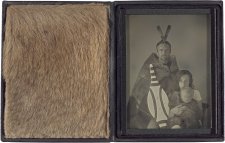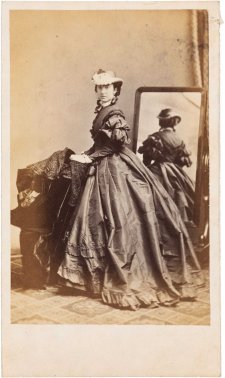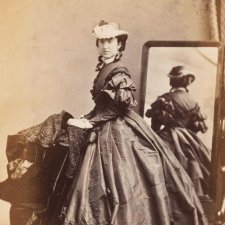Fannie Carandini (1850–1904) was one of the five daughters of Jerome Carandini, Marquis of Sarzano (1803–1870), an Italian political exile, and his wife Marie (née Burgess, 1826–1894), better known as the esteemed singer ‘Madame Carandini’. Born in Hobart, Fannie and her oldest sister Rosina (1844–1932) began their singing training early, their father’s straitened circumstances and their mother’s dominance and ambition determining that they would have careers on the musical stage. The sisters performed alongside their mother in the 1860s as the ‘Carandini Family Troupe’, touring widely and earning the warm approbation of audiences. One report of a performance in Bendigo in 1869 noted the ‘power, sweetness, and purity’ of Fannie’s voice and stated that the sisters ‘were very successful in a number of duets’. Their rendition of ‘Beware! Beware! I trust her not’, according to the report, ‘proved very laughter provoking, and had to be repeated in answer to an enthusiastic encore’. Rosina also performed as a principal soloist on several occasions, winning much respect and admiration. When Prince Alfred visited Melbourne in 1868 he was so impressed with Rosina that he promised to make it possible for her to study in Europe. The opportunity, however, was one of many that she declined so as not to transgress notions of acceptable behaviour for married women. Fannie married in India in 1875 and eventually moved to England. Darwin’s Fannie Bay and its namesake suburb are held to be named after her, having been surveyed in 1868 by men who’d heard her sing in Adelaide a few weeks earlier.
Photographer Charles Hewitt was working in Melbourne by 1860 and was one of the founding members of the Photographic Society of Victoria. Initially he was in business with Charles Nettleton, but by 1866, when examples of his work were included in the Melbourne Intercolonial Exhibition, he was working independently. He occupied a studio at 95 Swanston Street from 1867, in which year the ‘Misses Carandini’ performed in Melbourne several times, including in the ‘Charitable Music Festival’ at the Exhibition Building in April. Hewitt’s portraits of the sisters would in all likelihood have been created to coincide with one such performance. Rosina is depicted in a day dress with deepened waistline, full-length sleeves and high neckline, while Fannie wears an off-the-shoulder, bell-shaped dress, more suited to evening attire. Their full skirts are worn over a cage crinoline with a boned corset tightened over a chemise in typical mid-nineteenth century fashion. They wear their hair with a central part and swept back from the face to form a chignon. Both are adorned with braided hair chains, worn with sisterly sentiment, complimenting the lace trimmings on their frocks, decorative belts and ornamented surrounds.
Purchased with funds provided by Graham Smith 2009
The National Portrait Gallery respects the artistic and intellectual property rights of others. Works of art from the collection are reproduced as per the
Australian Copyright Act 1968 (Cth). The use of images of works from the collection may be restricted under the Act. Requests for a reproduction of a work of art can be made through a
Reproduction request. For further information please contact
NPG Copyright.


















